In this guide, we will discuss the different categories of stainless steel and what makes them special as well as how to choose the best one. Whether you are concerned with corrosion, strength, or formability specifications, you will be able to learn all the information. Read on to find out the most critical features that set them apart and how they fare in practical use.
What do the Grades of Stainless Steel Mean?
Stainless steel grades are of different formulations. Each grade has particular attributes and applications due to the presence of chromium, nickel, molybdenum, and carbon. These elements affect such properties as corrosion, mechanical properties, high-temperature properties, and fabrication characteristics.
For instance, 304 stainless steel (18/8), contains 18% chromium and 8% nickel and provides average corrosion resistance for uses such as kitchen utensils. While 316 stainless steel, including molybdenum, raises the metal’s tolerance to salt and chemicals. Thus, it is ideal for marine and medical applications. 430 stainless steel is comparatively cheaper and has lower corrosion tolerance than 304, and 316.
Moreover, grades like AISI, the American Iron and Steel Institute which uses numeral designations such as 304, 316, 430, and so on define their characteristics. The system allows users to choose the right grade depending on the strength, cost, and environment required.
What are the Different Types of Stainless Steel?
The most common types of stainless steel:
1. Austenitic Stainless Steel
Austenitic stainless steel is the most common, making up about 70% of all stainless steel produced. It normally comprises chromium between 16 and 26% and nickel around 6 and 22% with the microstructure of austenite. The intended structure makes the steel non-magnetic, resistant to corrosion, and able to work well under high and low thermal conditions.
The production process involves:
- Solidifying the raw materials as a slab in an electric arc furnace.
- To get a uniform alloy composition; add nickel and molybdenum to the molten steel.
- The conversion of steel into slabs, blooms, or billets.
- Softening of the steel reduces residual stresses and increases the material’s ability to deform without failure.
- Cold-working or hot-working to get the required mechanical characteristics.
Austenitic stainless steel typically belongs to categories 304 and 316. They are suitable for food and chemical industries as well as medical instruments.
304 Stainless Steel
- Composition:18% Cr, 8% Ni, 0.08% C
- Properties: It is also known as “18/8 stainless steel”. It is applied not only in kitchen appliances and pots and pans but also in various medical equipment.
- Uses: The food processing industry, the pharmaceutical machinery industry, and the kitchen equipment industry.
316 Stainless Steel
- Composition: 16% Cr, 10% Ni, 2% Mo and 0.08% C
- Properties:316 stainless steel is almost identical to 304. It contains 2% molybdenum which offers the material increased protection against chloride formation that is common in coastal regions. The grade is also immune to pitting as well as crevice corrosion.
- Uses: Ship components, chemical industry, orthopedic devices, and surgical tools.
2. Ferritic Stainless Steel
Ferritic stainless steels are iron-chromium alloys containing less than 10.5% chromium and no more than 1% nickel. They have chromium contents between 10.5% and 30% and normally are magnetic. Ferritic stainless steels are produced using a simpler process than austenitic types, mainly involving:
- Inoculation of molten Fe with chromium, sometimes alloy with small quantities of carbon and other elements such as molybdenum.
- The material is then shaped by hot rolling into steel sheets
- Normalizing to remove the excess of hardness and to make the material more workable.
Ferritic are a type of 430 and 409. They are used in automotive exhausts, architectural applications, and home appliances because of their ability to resist oxidation and corrosion at lower costs.
430 Stainless Steel
- Composition:17% Cr, 0.12% C
- Properties: 430 stainless steel is a ferritic material. It has been known for its satisfactory corrosion features and high magnetization. 430 has a place in using stainless steel where high corrosion is not a factor but the cost is an issue.
- Uses: Cars exhaust systems, home appliances such as fridges, and trims on buildings.
3. Martensitic Stainless Steel
Martensitic stainless steel is a high-carbon steel containing 12-18% chromium and 0.1-1.2% carbon. This type of stainless steel is produced by:
- The process of melting and mixing high carbon content into the steel.
- Tempering the converter steel to form martensite after heat treatment results in a hard but brittle structure.
- The process of ‘normalizing’ or ‘softening’ of the steel reduces the brittle nature. The earlier process of ‘hardening’ creates on the steel.
Martensitic steels include the 410 and 420 types and are used in cutlery, knives, surgical instruments, and other applications where strength and hardness are imperative.
410 Stainless Steel
- Composition:12% Cr, 0.15% C
- Properties: Martensitic stainless steel for example 410 has a higher percentage of carbon than the other grades. This makes it harder to bend but has poor corrosion resistance. This grade can be heat treated to a wide range of mechanical properties including hardness, strength, and abrasion resistance.
- Uses: Aerospace industry components, pressure vessels, pipes, fittings, gears, automotive components, and structural parts.
416 Stainless Steel
- Composition:12% Cr, 0.15% C, 0.60% S
- Properties:416 stainless steel is a martensitic grade of metal. The sulfur content is included to improve the ease of its working. This grade has high strength and hardness but inferior corrosion resistance to the austenitic steel 304. It is best used when ease of machining is an important factor.
- Uses: Car parts, shafts, gears, and other auto parts that involve high stress and need accurate cutting.
4. Duplex Stainless Steel
Duplex stainless steel consists of both the austenitic and the ferritic forms. It’s comparatively stronger while more corrosion-resistant. The production process involves:
- A balanced ratio ranging from 22-25% of chromium, 4-7% of nickel, and a minor amount of molybdenum.
- Hot-working to attain the right proportion of the two phases.
- Heat treatment to achieve the best possible mechanical characteristics and corrosion protection.
The chemical processing, oil and gas, and marine industries require high strength and resistance to pitting, which is provided by the duplex stainless steel grades, including 2205 and 2507.
Duplex Stainless Steel (2205)
- Composition: 22% Cr, 5% Ni, 3% Mo, 0.03% C
- Properties: The properties of duplex stainless steel are so designed to include the benefits of both austenitic and ferritic stainless steel grades, with the added advantage of high strength and better corrosion resistance. It has a higher resistance to chloride environments due to the presence of chromium, nickel, and molybdenum.
- Uses: Chemical processing, oil and gas, desalination plants, and marine business.
5. Precipitation hardening stainless steel
PH stainless steels are special steels. These materials gain their strength through heat treatment, not by alloying. They usually contain chromium, nickel, and a small amount of copper. The production process includes:
- Solution treatment to allow the alloying elements to diffuse into a matrix solid.
- Steel heating at 800°C to 1000°Cencourages the formation of strengthening phases.
- Cold-working is necessary to produce a high tensile strength.
PH stainless steels including 17-4 PH are applied in aerospace, nuclear, and high-stress industrial uses.
Melting Points of Common Stainless Steel Grades
| Grade | Melting Point (°C) | Melting Point (°F) | Melting Point (K) |
| 304 (Austenitic) | 1400–1450°C | 2552–2642°F | 1673–1723 K |
| 316 (Austenitic) | 1375–1400°C | 2507–2552°F | 1648–1673 K |
| 430 (Ferritic) | 1400–1510°C | 2552–2750°F | 1673–1783 K |
| 410 (Martensitic) | 1480–1530°C | 2700–2806°F | 1753–1803 K |
| 2205 (Duplex) | 1425–1475°C | 2597–2687°F | 1698–1748 K |
| 440C (Martensitic) | 1450–1500°C | 2642–2732°F | 1723–1773 K |
How Do You Determine the Right Type for Your Needs?
When choosing the right type of stainless steel, you have to take into account features such as corrosion, strength, formability, and cost. For areas that are likely to come into contact with water, any corrosive solution, or saltwater, austenitic grades such as 304 or 316 can be ideal.
When greater strength and wear resistance are required, such as for heavily loaded bearings or gears, martensitic types, such as 410 or 416, may be used where machinability is important. In terms of cost, if there’s less exposure to corrosive environments, and buy, ferritic types such as 430 are favored.
For higher stress and corrosive applications, duplex grades such as 2205 offer strength together with resistance to cracking and pitting, making it suitable for extreme uses such as marine or chemical industries.
Choosing the Right Stainless Steel Fabrication Partner – Topsbest-Precision
It’s imperative to choose the right partner in stainless steel fabrication for your project. Whether you are manufacturing a one-off part, a machined product, or a high-volume production run, a good partner guarantees quality and on-time delivery. Tops Precision is your one-stop shop for stainless steel services – knowledge, technology, and quality service. Select a partner that holds sustainability as one of its key priorities. Tops Precision upholds environmental policy by minimizing wastage as you can expect your project to be environmentally friendly.




3 thoughts on “Explore Different Types of Stainless Steel”